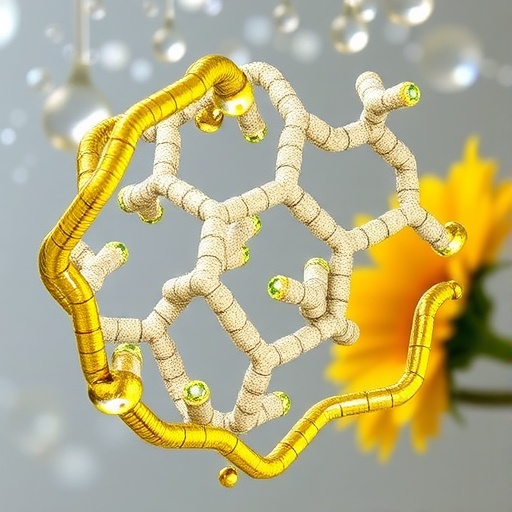In recent years, the search for sustainable materials has gained immense traction within the field of biochemistry and renewable resources. A groundbreaking study by Guo, Zhao, Liu, and colleagues has emerged, emphasizing the innovative synthesis of hydrophobic starch esters derived from the reclamation of sunflower oil refining sludge. This research not only highlights the potential of transforming waste into value-added products but also opens a dialogue on the pivotal role of recycling and resource efficiency in today’s ecological landscape.
The primary objective of the research focuses on synthesizing hydrophobic starch esters utilizing unsaturated fatty acids sourced from the byproducts of sunflower oil refining processes. In a world where food production generates significant waste, refining processes often leave behind sludges that, until now, have been underutilized. By converting these wastes into functional materials, researchers have taken a significant step towards circular economy principles where waste can be repurposed rather than discarded.
In the initial stages of the research, the team analyzed the current methods utilized in sunflower oil refining. Sunflower oil is one of the most extensively consumed edible oils worldwide. However, it generates considerable amounts of sludge during refining, mainly consisting of triglycerides, free fatty acids, and other organic materials. This composition makes sunflower oil refining sludge an attractive candidate for biochemical conversions, paving the way for novel applications that could mitigate waste and environmental impact.
The methodological approach employed in this study involved the esterification of starch with the unsaturated fatty acids recovered from the sunflower oil sludge. Through systematic experimentation, the researchers optimized conditions such as temperature, time, and catalyst concentration to achieve high yields of the desired hydrophobic starch esters. These esters showcase a remarkable ability to repel water, underscoring their potential applications in various industries, from agriculture to packaging.
The hydrophobic nature of these starch esters poses multiple advantages in agricultural applications. They could be utilized as effective coating materials for seeds, enhancing germination rates and crop resilience against waterborne diseases. Additionally, these hydrophobic compounds may be applied in soil treatment, improving water retention and promoting healthier soil ecosystems. Researchers suggest that by integrating such materials into farming practices, farmers could achieve higher crop yields while conserving water resources.
In the realm of packaging, the hydrophobic starch esters synthesized offer a promising alternative to conventional petroleum-based plastics. With growing concerns regarding plastic pollution, the transition to biodegradable materials is imperative. Starch-based polymers are not only eco-friendly but also derived from renewable resources. The synthesis of hydrophobic esters with unique properties could revolutionize how we approach packaging, providing a biodegradable solution that does not compromise functionality.
Furthermore, the study delineates extensive characterization of the synthesized esters, employing techniques such as nuclear magnetic resonance (NMR) spectroscopy and infrared spectroscopy. Such meticulous characterization is essential for confirming the chemical structure and ensuring that the materials generated possess the desired properties for practical applications. The findings from these analyses proved instrumental in understanding the relationship between the structural attributes of the esters and their hydrophobic characteristics.
In addition to practical applications in agriculture and packaging, the research posits broader implications for waste management strategies. By adopting innovative methodologies for the conversion of agricultural waste into value-added products, this study champions a more sustainable future. It encourages stakeholders across various sectors to reconsider their waste management frameworks, pushing towards a more circular economic model that minimizes waste and maximizes resource utility.
The environmental implications of this research cannot be overstated. As societal awareness about sustainability increases, findings such as these contribute to the growing repository of knowledge advocating for green chemistry practices. Essentially, the conversion of waste into functional materials aligns with global sustainability objectives, fostering a greener, more resilient future for industries reliant on natural resources.
While the potential applications of these hydrophobic starch esters are widespread, further research is pivotal. Investigating the long-term stability, biodegradability, and overall environmental impact of these materials will be critical. Addressing these factors will solidify the role of hydrophobic starch esters as viable alternatives to existing materials and will help forge pathways toward innovative solutions in material science.
The innovative work conducted by Guo and colleagues demonstrates a significant advancement in the use of renewable resources and waste valorization. The synthesis of hydrophobic starch esters holds promise across multiple sectors, presenting an opportunity to revolutionize practices in agriculture and packaging. As we forge ahead, the knowledge gleaned from this research could inspire similar studies that delve into other agricultural byproducts, further unraveling the potential of waste to serve humanity’s needs.
Ultimately, the research serves as a springboard for future innovations in biopolymers and sustainable materials. By capitalizing on natural waste streams and incorporating biochemical processes, researchers can establish new paradigms for the acquisition and utilization of resources. This study stands as a testament to the ingenuity within the scientific community, championing a transition towards harmonizing economic viability with environmental stewardship.
This groundbreaking work by Guo, Zhao, Liu, and their team provides an insightful glimpse into the trajectory of sustainability in biochemistry and materials science. By fostering a future where waste is transformed into opportunity, we embrace the principles of resource efficiency, innovation, and ecological responsibility—all essential for navigating the challenges of the modern world.
Subject of Research: Synthesis of hydrophobic starch esters from sunflower oil refining sludge.
Article Title: Synthesis of Hydrophobic Starch Esters with Unsaturated Fatty Acids from Sunflower Oil Refining Sludge.
Article References:
Guo, HX., Zhao, JJ., Liu, XY. et al. Synthesis of Hydrophobic Starch Esters with Unsaturated Fatty Acids from Sunflower Oil Refining Sludge.
Waste Biomass Valor (2025). https://doi.org/10.1007/s12649-025-03391-0
Image Credits: AI Generated
DOI: https://doi.org/10.1007/s12649-025-03391-0
Keywords: Sustainable materials, hydrophobic starch esters, waste valorization, sunflower oil refining sludge, renewable resources, biodegradable packaging.




